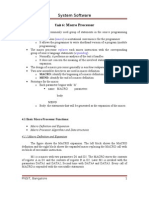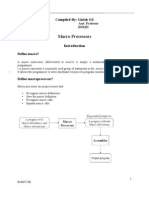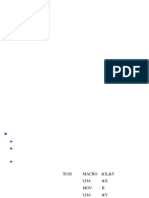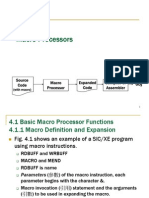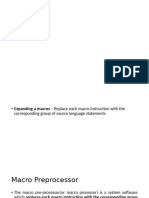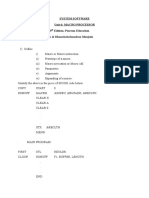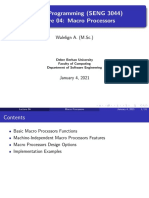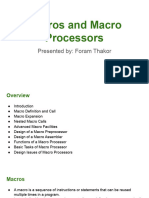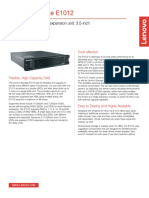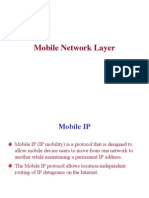Macro Processor Notes
Macro Processor Notes
Uploaded by
sebinbenjaminCopyright:
Available Formats
Macro Processor Notes
Macro Processor Notes
Uploaded by
sebinbenjaminOriginal Description:
Copyright
Available Formats
Share this document
Did you find this document useful?
Is this content inappropriate?
Copyright:
Available Formats
Macro Processor Notes
Macro Processor Notes
Uploaded by
sebinbenjaminCopyright:
Available Formats
Chapter 4 Macro Processor
S. Seema Dept of CSE, MSRIT 1
Chapter 4: Macro Processor
A Macro represents a commonly used group of statements in the source programming
language.
A macro instruction (macro) is a notational convenience for the programmer
o It allows the programmer to write shorthand version of a program (module
programming)
The macro processor replaces each macro instruction with the corresponding
group of source language statements (expanding)
o Normally, it performs no analysis of the text it handles.
o It does not concern the meaning of the involved statements during macro
expansion.
The design of a macro processor generally is machine independent!
Two new assembler directives are used in macro definition
o MACRO: identify the beginning of a macro definition
o MEND: identify the end of a macro definition
Prototype for the macro
o Each parameter begins with &
name MACRO parameters
:
body
:
MEND
o Body: the statements that will be generated as the expansion of the macro.
4.1 Basic Macro Processor Functions:
Macro Definition and Expansion
Macro Processor Algorithms and Data structures
4.1.1 Macro Definition and Expansion:
The figure shows the MACRO expansion. The left block shows the MACRO
definition and the right block shows the expanded macro replacing the MACRO call with
its block of executable instruction.
M1 is a macro with two parameters D1 and D2. The MACRO stores the contents
of register A in D1 and the contents of register B in D2. Later M1 is invoked with the
parameters DATA1 and DATA2, Second time with DATA4 and DATA3. Every call of
MACRO is expended with the executable statements.
Chapter 4 Macro Processor
S. Seema Dept of CSE, MSRIT 2
Fig 4.1
The statement M1 DATA1, DATA2 is a macro invocation statements that gives the
name of the macro instruction being invoked and the arguments (M1 and M2) to be used
in expanding. A macro invocation is referred as a Macro Call or Invocation.
Macro Expansion:
The program with macros is supplied to the macro processor. Each macro
invocation statement will be expanded into the statement s that form the body of the
macro, with the arguments from the macro invocation substituted for the parameters in
the macro prototype. During the expansion, the macro definition statements are deleted
since they are no longer needed.
The arguments and the parameters are associated with one another according to
their positions. The first argument in the macro matches with the first parameter in the
macro prototype and so on.
After macro processing the expanded file can become the input for the Assembler.
The Macro Invocation statement is considered as comments and the statement generated
from expansion is treated exactly as though they had been written directly by the
programmer.
The difference between Macros and Subroutines is that the statement s from the
body of the Macro is expanded the number of times the macro invocation is encountered,
whereas the statement of the subroutine appears only once no matter how many times the
subroutine is called. Macro instructions will be written so that the body of the macro
contains no labels.
Problem of the label in the body of macro:
o If the same macro is expanded multiple times at different places in the
program
o There will be duplicate labels, which will be treated as errors by the
assembler.
Solutions:
Chapter 4 Macro Processor
S. Seema Dept of CSE, MSRIT 3
o Do not use labels in the body of macro.
o Explicitly use PC-relative addressing instead.
Ex, in RDBUFF and WRBUFF macros,
o JEQ *+11
o JLT *-14
It is inconvenient and error-prone.
The following program shows the concept of Macro Invocation and Macro
Expansion.
Chapter 4 Macro Processor
S. Seema Dept of CSE, MSRIT 4
Fig 4.2
4.1.2 Macro Processor Algorithm and Data Structure:
Design can be done as two-pass or a one-pass macro. In case of two-pass
assembler.
Two-pass macro processor
You may design a two-pass macro processor
o Pass 1:
Process all macro definitions
o Pass 2:
Expand all macro invocation statements
However, one-pass may be enough
o Because all macros would have to be defined during the first pass before
any macro invocations were expanded.
The definition of a macro must appear before any statements that
invoke that macro.
Moreover, the body of one macro can contain definitions of the other macro
Consider the example of a Macro defining another Macro.
In the example below, the body of the first Macro (MACROS) contains statement
that define RDBUFF, WRBUFF and other macro instructions for SIC machine.
The body of the second Macro (MACROX) defines the se same macros for
SIC/XE machine.
A proper invocation would make the same program to perform macro invocation
to run on either SIC or SIC/XEmachine.
Chapter 4 Macro Processor
S. Seema Dept of CSE, MSRIT 5
MACROS for SIC machine
Fig 4.3(a)
MACROX for SIC/XE Machine
Fig 4.3(b)
A program that is to be run on SIC system could invoke MACROS whereas a
program to be run on SIC/XE can invoke MACROX.
However, defining MACROS or MACROX does not define RDBUFF and
WRBUFF.
These definitions are processed only when an invocation of MACROS or
MACROX is expanded.
Chapter 4 Macro Processor
S. Seema Dept of CSE, MSRIT 6
One-Pass Macro Processor:
A one-pass macro processor that alternate between macro definition and macro
expansion in a recursive way is able to handle recursive macro definition.
Restriction
o The definition of a macro must appear in the source program before any
statements that invoke that macro.
o This restriction does not create any real inconvenience.
The design considered is for one-pass assembler. The data structures required are:
DEFTAB (Definition Table)
o Stores the macro definition including macro prototype and macro body
o Comment lines are omitted.
o References to the macro instruction parameters are converted to a
positional notation for efficiency in substituting arguments.
NAMTAB (Name Table)
o Stores macro names
o Serves as an index to DEFTAB
Pointers to the beginning and the end of the macro definition
(DEFTAB)
ARGTAB (Argument Table)
o Stores the arguments according to their positions in the argument list.
o As the macro is expanded the arguments from the Argument table are
substituted for the corresponding parameters in the macro body.
o The figure below shows the different data structures described and their
relationship.
Fig 4.4
Chapter 4 Macro Processor
S. Seema Dept of CSE, MSRIT 7
The above figure shows the portion of the contents of the table during the processing of
the program in page no. 3. In fig 4.4(a) definition of RDBUFF is stored in DEFTAB, with
an entry in NAMTAB having the pointers to the beginning and the end of the definition.
The arguments referred by the instructions are denoted by the their positional notations.
For example,
TD =X?1
The above instruction is to test the availability of the device whose number is given by
the parameter &INDEV. In the instruction this is replaced by its positional value? 1.
Figure 4.4(b) shows the ARTAB as it would appear during expansion of the RDBUFF
statement as given below:
CLOOP RDBUFF F1, BUFFER, LENGTH
For the invocation of the macro RDBUFF, the first parameter is F1 (input device code),
second is BUFFER (indicating the address where the characters read are stored), and the
third is LENGTH (which indicates total length of the record to be read). When the ?n
notation is encountered in a line fro DEFTAB, a simple indexing operation supplies the
proper argument from ARGTAB.
The algorithm of the Macro processor is given below. This has the procedure DEFINE to
make the entry of macro name in the NAMTAB, Macro Prototype in DEFTAB.
EXPAND is called to set up the argument values in ARGTAB and expand a Macro
Invocation statement. Procedure GETLINE is called to get the next line to be processed
either from the DEFTAB or from the file itself.
When a macro definition is encountered it is entered in the DEFTAB. The normal
approach is to continue entering till MEND is encountered. If there is a program having a
Macro defined within another Macro. While defining in the DEFTAB the very first
MEND is taken as the end of the Macro definition. This does not complete the definition
as there is another outer Macro which completes the difintion of Macro as a whole.
Therefore the DEFINE procedure keeps a counter variable LEVEL. Every time a Macro
directive is encountered this counter is incremented by 1. The moment the innermost
Macro ends indicated by the directive MEND it starts decreasing the value of the counter
variable by one. The last MEND should make the counter value set to zero. So when
LEVEL becomes zero, the MEND corresponds to the original MACRO directive.
Most macro processors allow thr definitions of the commonly used instructions to
appear in a standard system library, rather than in the source program. This makes the use
of macros convenient; definitions are retrieved from the library as they are needed during
macro processing.
Chapter 4 Macro Processor
S. Seema Dept of CSE, MSRIT 8
Fig 4.5
Chapter 4 Macro Processor
S. Seema Dept of CSE, MSRIT 9
Algorithms
Chapter 4 Macro Processor
S. Seema Dept of CSE, MSRIT 10
Fig 4.6
4.1.3 Comparison of Macro Processor Design
One-pass algorithm
o Every macro must be defined before it is called
o One-pass processor can alternate between macro definition and macro
expansion
o Nested macro definitions are allowed but nested calls are not allowed.
Two-pass algorithm
o Pass1: Recognize macro definitions
o Pass2: Recognize macro calls
o Nested macro definitions are not allowed
Chapter 4 Macro Processor
S. Seema Dept of CSE, MSRIT 11
4.1 Machine-independent Macro-Processor Features.
The design of macro processor doesnt depend on the architecture of the machine.
We will be studying some extended feature for this macro processor. These features are:
Concatenation of Macro Parameters
Generation of unique labels
Conditional Macro Expansion
Keyword Macro Parameters
4.2.1 Concatenation of unique labels:
Most macro processor allows parameters to be concatenated with other character
strings. Suppose that a program contains a series of variables named by the symbols
XA1, XA2, XA3,, another series of variables named XB1, XB2, XB3,, etc. If similar
processing is to be performed on each series of labels, the programmer might put this as a
macro instruction. The parameter to such a macro instruction could specify the series of
variables to be operated on (A, B, etc.). The macro processor would use this parameter to
construct the symbols required in the macro expansion (XA1, Xb1, etc.).
Suppose that the parameter to such a macro instruction is named &ID. The body
of the macro definition might contain a statement like
LDA X&ID1
Fig 4.7
& is the starting character of the macro instruction; but the end of the parameter is not
marked. So in the case of &ID1, the macro processor could deduce the meaning that was
intended. If the macro definition contains contain &ID and &ID1 as parameters, the
situation would be unavoidably ambiguous.
Most of the macro processors deal with this problem by providing a special
concatenation operator. In the SIC macro language, this operator is the character . Thus
the statement LDA X&ID1 can be written as
LDA X&ID
Chapter 4 Macro Processor
S. Seema Dept of CSE, MSRIT 12
Fig 4.8
The above figure shows a macro definition that uses the concatenation operator as
previously described. The statement SUM A and SUM BETA shows the invocation
statements and the corresponding macro expansion.
4.2.2 Generation of Unique Labels
As discussed it is not possible to use labels for the instructions in the macro
definition, since every expansion of macro would include the label repeatedly which is
not allowed by the assembler. This in turn forces us to use relative addressing in the jump
instructions. Instead we can use the technique of generating unique labels for every
macro invocation and expansion. During macro expansion each $ will be replaced with
$XX, where xx is a two-character alphanumeric counter of the number of macro
instructions expansion.
For example,
XX = AA, AB, AC
This allows 1296 macro expansions in a single program.
Chapter 4 Macro Processor
S. Seema Dept of CSE, MSRIT 13
The following program shows the macro definition with labels to the instruction.
The following figure shows the macro invocation and expansion first time.
If the macro is invoked second time the labels may be expanded as $ABLOOP
$ABEXIT.
Chapter 4 Macro Processor
S. Seema Dept of CSE, MSRIT 14
4.2.3 Conditional Macro Expansion
There are applications of macro processors that are not related to assemblers or
assembler programming.
Conditional assembly depends on parameters provides
MACRO &COND
..
IF (&COND NE )
part I
ELSE
part II
ENDIF
ENDM
Part I is expanded if condition part is true, otherwise part II is expanded. Compare
operators: NE, EQ, LE, GT.
Macro-Time Variables:
Macro-time variables (often called as SET Symbol) can be used to store working
values during the macro expansion. Any symbol that begins with symbol & and not a
macro instruction parameter is considered as macro-time variable. All such variables are
initialized to zero.
Fig 4.9(a)
Chapter 4 Macro Processor
S. Seema Dept of CSE, MSRIT 15
Figure 4.5(a) gives the definition of the macro RDBUFF with the parameters &INDEV,
&BUFADR, &RECLTH, &EOR, &MAXLTH. According to the above program if
&EOR has any value, then &EORCK is set to 1 by using the directive SET, otherwise it
retains its default value 0.
Fig 4.9(b) Use of Macro-Time Variable with EOF being NOT NULL
Fig 4.9(c) Use of Macro-Time conditional statement with EOF being NULL
Chapter 4 Macro Processor
S. Seema Dept of CSE, MSRIT 16
Fig 4.9(d) Use of Time-variable with EOF NOT NULL and MAXLENGTH being NULL
The above programs show the expansion of Macro invocation statements with different
values for the time variables. In figure 4.9(b) the &EOF value is NULL. When the macro
invocation is done, IF statement is executed, if it is true EORCK is set to 1, otherwise
normal execution of the other part of the program is continued.
The macro processor must maintain a symbol table that contains the value of all macro-
time variables used. Entries in this table are modified when SET statements are
processed. The table is used to look up the current value of the macro-time variable
whenever it is required.
When an IF statement is encountered during the expansion of a macro, the specified
Boolean expression is evaluated.
If the value of this expression TRUE,
The macro processor continues to process lines from the DEFTAB until it
encounters the ELSE or ENDIF statement.
If an ELSE is found, macro processor skips lines in DEFTAB until the next
ENDIF.
Once it reaches ENDIF, it resumes expanding the macro in the usual way.
If the value of the expression is FALSE,
The macro processor skips ahead in DEFTAB until it encounters next ELSE or
ENDIF statement.
The macro processor then resumes normal macro expansion.
The macro-time IF-ELSE-ENDIF structure provides a mechanism for either
generating(once) or skipping selected statements in the macro body. There is another
Chapter 4 Macro Processor
S. Seema Dept of CSE, MSRIT 17
construct WHILE statement which specifies that the following line until the next ENDW
statement, are to be generated repeatedly as long as a particular condition is true. The
testing of this condition, and the looping are done during the macro is under expansion.
The example shown below shows the usage of Macro-Time Looping statement.
WHILE-ENDW structure
When an WHILE statement is encountered during the expansion of a macro, the
specified Boolean expression is evaluated.
TRUE
o The macro processor continues to process lines from DEFTAB until it
encounters the next ENDWstatement.
o When ENDW is encountered, the macro processor returns to the preceding
WHILE, re-evaluates the Boolean expression, and takes action based
on the new value.
FALSE
o The macro processor skips ahead in DEFTAB until it finds the next
ENDW statement and then resumes normal macro expansion.
Chapter 4 Macro Processor
S. Seema Dept of CSE, MSRIT 18
4.2.4 Keyword Macro Parameters
All the macro instruction definitions used positional parameters. Parameters and
arguments are matched according to their positions in the macro prototype and the macro
invocation statement. The programmer needs to be careful while specifying the
arguments. If an argument is to be omitted the macro invocation statement must contain a
null argument mentioned with two commas.
Positional parameters are suitable for the macro invocation. But if the macro
invocation has large number of parameters, and if only few of the values need to be used
in a typical invocation, a different type of parameter specification is required (for
example, in many cases most of the parameters may have default values, and the
invocation may mention only the changes from the default values).
Ex: XXX MACRO &P1, &P2, ., &P20, .
XXX A1, A2,,,,,,,,,,,,A20,..
Null arguments
Keyword parameters
Each argument value is written with a keyword that names the corresponding
parameter.
Arguments may appear in any order.
Null arguments no longer need to be used.
Ex: XXX P1=A1, P2=A2, P20=A20.
It is easier to read and much less error-prone than the positional method.
Chapter 4 Macro Processor
S. Seema Dept of CSE, MSRIT 19
Chapter 4 Macro Processor
S. Seema Dept of CSE, MSRIT 20
Fig 4.10 Example showing the usage of Keyword Parameter
4.3 Macro Processor Design Options
4.3.1 Recursive Macro Expansion
We have seen an example of the definition of one macro instruction by another. But we
have not dealt with the invocation of one macro by another. The following example
shows the invocation of one macro by another macro.
Chapter 4 Macro Processor
S. Seema Dept of CSE, MSRIT 21
Problem of Recursive Expansion
Previous macro processor design cannot handle such kind of recursive macro
invocation and expansion
o The procedure EXPAND would be called recursively, thus the invocation
arguments in the ARGTAB will be overwritten. (P.201)
o The Boolean variable EXPANDING would be set to FALSE when the
inner macro expansion is finished, i.e., the macro process would forget
that it had been in the middle of expanding an outer macro.
Solutions
o Write the macro processor in a programming language that allows
recursive calls, thus local variables will be retained.
o If you are writing in a language without recursion support, use a stack to
take care of pushing and popping local variables and return addresses.
Chapter 4 Macro Processor
S. Seema Dept of CSE, MSRIT 22
The procedure EXPAND would be called when the macro was recognized. The
arguments from the macro invocation would be entered into ARGTAB as follows:
Parameter Value
1 BUFFER
2 LENGTH
3 F1
4 (unused)
- -
The Boolean variable EXPANDING would be set to TRUE, and expansion of the macro
invocation statement would begin. The processing would proceed normally until
statement invoking RDCHAR is processed. This time, ARGTAB would look like
Parameter Value
1 F1
2 (Unused)
-- --
At the expansion, when the end of RDCHAR is recognized, EXPANDING would be set
to FALSE. Thus the macro processor would forget that it had been in the middle of
expanding a macro when it encountered the RDCHAR statement. In addition, the
arguments from the original macro invocation (RDBUFF) would be lost because the
value in ARGTAB was overwritten with the arguments from the invocation of
RDCHAR.
4.3.2 General-Purpose Macro Processors
Macro processors that do not dependent on any particular programming language,
but can be used with a variety of different languages
Pros
o Programmers do not need to learn many macro languages.
o Although its development costs are somewhat greater than those for a
language specific macro processor, this expense does not need to be
repeated for each language, thus save substantial overall cost.
Cons
o Large number of details must be dealt with in a real programming
language
Situations in which normal macro parameter substitution should
not occur, e.g., comments.
Facilities for grouping together terms, expressions, or statements
Tokens, e.g., identifiers, constants, operators, keywords
Syntax had better be consistent with the source programming
language
Chapter 4 Macro Processor
S. Seema Dept of CSE, MSRIT 23
4.3.3 Macro Processing within Language Translators
The macro processors we discussed are called Preprocessors.
o Process macro definitions
o Expand macro invocations
o Produce an expanded version of the source program, which is then used as
input to an assembler or compiler
You may also combine the macro processing functions with the language
translator:
o Line-by-line macro processor
o Integrated macro processor
4.3.4 Line-by-Line Macro Processor
Used as a sort of input routine for the assembler or compiler
o Read source program
o Process macro definitions and expand macro invocations
o Pass output lines to the assembler or compiler
Benefits
o Avoid making an extra pass over the source program.
o Data structures required by the macro processor and the language translator
can be combined (e.g., OPTAB and NAMTAB)
o Utility subroutines can be used by both macro processor and the language
translator.
Scanning input lines
Searching tables
Data format conversion
o It is easier to give diagnostic messages related to the source statements
4.3.5 Integrated Macro Processor
An integrated macro processor can potentially make use of any information about
the source program that is extracted by the language translator.
o Ex (blanks are not significant in FORTRAN)
DO 100 I = 1,20
a DO statement
DO 100 I = 1
An assignment statement
DO100I: variable (blanks are not significant in FORTRAN)
An integrated macro processor can support macro instructions that depend upon
the context in which they occur.
You might also like
- 286 Ho 722.9 062504Document79 pages286 Ho 722.9 062504arkhom197% (29)
- 9100 9500 9700 HR Treadmill PDFDocument140 pages9100 9500 9700 HR Treadmill PDFrocky3xbNo ratings yet
- Practical Monte Carlo Simulation with Excel - Part 2 of 2: Applications and DistributionsFrom EverandPractical Monte Carlo Simulation with Excel - Part 2 of 2: Applications and DistributionsRating: 2 out of 5 stars2/5 (1)
- System Software Notes 5TH Sem VtuDocument25 pagesSystem Software Notes 5TH Sem VtuNeha Chinni50% (2)
- CH4 - MACROPROCESSORSDocument18 pagesCH4 - MACROPROCESSORSsisayyohannes997No ratings yet
- SS Macro ProcessorDocument24 pagesSS Macro Processoringaleabhijeet2010No ratings yet
- Macro ProcessorDocument22 pagesMacro ProcessorYogesh Yogi100% (1)
- Ch6 Macro ProcessorsDocument4 pagesCh6 Macro ProcessorsRama Muniswara Rao ENo ratings yet
- System Software ModuleDocument37 pagesSystem Software ModuleFhvxgNo ratings yet
- Chapter 4 Macro Processors (New)Document29 pagesChapter 4 Macro Processors (New)Akshay AgrawalNo ratings yet
- System-Software Unit IVDocument9 pagesSystem-Software Unit IVpalanichelvam100% (8)
- Unit IV System SoftwareDocument10 pagesUnit IV System Softwaresilicongmaster7060No ratings yet
- Macro Processors: Basic Function Machine-Independent Features Design Options Implementation ExamplesDocument18 pagesMacro Processors: Basic Function Machine-Independent Features Design Options Implementation ExamplesCharan SainiNo ratings yet
- Macro ProcessorDocument53 pagesMacro ProcessorJeena Mol AbrahamNo ratings yet
- UNIT IV Macro ProcessorDocument14 pagesUNIT IV Macro Processorelias ferhanNo ratings yet
- Macro_PreprocessorDocument75 pagesMacro_PreprocessorMegha BNo ratings yet
- Exp 9 SPCCDocument14 pagesExp 9 SPCCwork.mihirkateNo ratings yet
- SP 11Document50 pagesSP 11Anonymous V0TkkvWNo ratings yet
- Macro Processors: Unit - IvDocument87 pagesMacro Processors: Unit - IvdevilaliNo ratings yet
- Macro 1Document8 pagesMacro 1Atul Sharma100% (1)
- Notes of System ProgrammingDocument36 pagesNotes of System ProgrammingJaspreet SinghNo ratings yet
- SP 11Document50 pagesSP 11Saurabh IyerNo ratings yet
- Synopsis MacroDocument4 pagesSynopsis MacroDeepak RadhakrishnaNo ratings yet
- Chapter 4 Macro Processors: - Basic Macro Processor FunctionsDocument30 pagesChapter 4 Macro Processors: - Basic Macro Processor FunctionsSasi Kumar IyyanNo ratings yet
- LPDocument18 pagesLPAnusha deviNo ratings yet
- Macro Processors: Source Code Macro Processor Expanded Code Compiler or AssemblerDocument51 pagesMacro Processors: Source Code Macro Processor Expanded Code Compiler or AssemblerWaqas MahmoodNo ratings yet
- Unit IvDocument78 pagesUnit IvSudhakar SelvamNo ratings yet
- Macro Part1Document32 pagesMacro Part1Anver S RNo ratings yet
- Macro Processors: Source Code Macro Processor Expanded Code Compiler or AssemblerDocument51 pagesMacro Processors: Source Code Macro Processor Expanded Code Compiler or AssemblerxsprasanthNo ratings yet
- Module 5Document26 pagesModule 5aswkh00videosNo ratings yet
- Macro Preprocessor Part 1Document33 pagesMacro Preprocessor Part 1Anila JohnsonNo ratings yet
- Module 5Document65 pagesModule 5alaina2026No ratings yet
- SP Unit2 RNPDocument103 pagesSP Unit2 RNP404badshah404No ratings yet
- Macro and Macro ProcessorsDocument4 pagesMacro and Macro Processorskanaiya valviNo ratings yet
- ch4 MacroDocument53 pagesch4 Macroakbisoi1No ratings yet
- CS303 M5-Ktunotes - inDocument122 pagesCS303 M5-Ktunotes - inFiromsa TesfayeNo ratings yet
- Macro ProcessorDocument44 pagesMacro ProcessorDanielLuci100% (1)
- SPCC Exp 4Document9 pagesSPCC Exp 4Dhyey ValeraNo ratings yet
- System Software Unit 6: Macro Processor Book: System Software, 3 Edition, Pearson Education by Leland L. Beck & Dhanabalachandran ManjulaDocument3 pagesSystem Software Unit 6: Macro Processor Book: System Software, 3 Edition, Pearson Education by Leland L. Beck & Dhanabalachandran ManjulaKrishnapriya MenonNo ratings yet
- 4.2 Machine-Independent Macro Processor FeaturesDocument47 pages4.2 Machine-Independent Macro Processor FeaturesAnila JohnsonNo ratings yet
- Spos - Unit 2Document178 pagesSpos - Unit 2Sushma BorkarNo ratings yet
- Chapter FourDocument30 pagesChapter FourTigist AlemuNo ratings yet
- Ch4 Macro ProcessorsDocument33 pagesCh4 Macro Processorsakbisoi1No ratings yet
- SPCC Ia1Document6 pagesSPCC Ia1vapog80368No ratings yet
- Isha Spos Lab Practical 2 (2203532)Document3 pagesIsha Spos Lab Practical 2 (2203532)Isha Awhale PatilNo ratings yet
- Macro Processors: S SeemaDocument28 pagesMacro Processors: S SeemamonajosephjustinNo ratings yet
- SPCC Exp2Document6 pagesSPCC Exp2sanjanabhosle27No ratings yet
- Macro Macro Processor PDFDocument53 pagesMacro Macro Processor PDFMariyam ArsiwalaNo ratings yet
- SS MacroDocument87 pagesSS Macrorohith1oNo ratings yet
- Module 5 NotesDocument63 pagesModule 5 NotesT A AsmaNo ratings yet
- Macro Processors Chap4Document11 pagesMacro Processors Chap4Anonymous jpeHV73mLzNo ratings yet
- SPCC - 3Document10 pagesSPCC - 3Ian ThomasNo ratings yet
- Macros and macro processorDocument43 pagesMacros and macro processordrmadhavpvtNo ratings yet
- System Programming AsignmentDocument11 pagesSystem Programming AsignmentnandankarkinshukNo ratings yet
- System Software: Dr. Manish Khare Macro ProcessorsDocument33 pagesSystem Software: Dr. Manish Khare Macro Processorshoneykanna2024No ratings yet
- MP Experiment 6Document2 pagesMP Experiment 6TANMAY KenyNo ratings yet
- C General 17Document3 pagesC General 17kok_oc25No ratings yet
- Module 5 Remaining NotesDocument15 pagesModule 5 Remaining Notesvani_V_prakashNo ratings yet
- MacroDocument48 pagesMacronadar uthayakumarNo ratings yet
- SAP interface programming with RFC and VBA: Edit SAP data with MS AccessFrom EverandSAP interface programming with RFC and VBA: Edit SAP data with MS AccessNo ratings yet
- SAS Macro Programming Made Easy, Third EditionFrom EverandSAS Macro Programming Made Easy, Third EditionRating: 3.5 out of 5 stars3.5/5 (3)
- Renault ECUDocument21 pagesRenault ECUNeptali Gamez T.No ratings yet
- EC 2 Lab ManualDocument94 pagesEC 2 Lab ManualEzhilya VenkatNo ratings yet
- Pages 2 User GuideDocument2 pagesPages 2 User GuideKhan MohhammadNo ratings yet
- HTC Elf Service ManualDocument73 pagesHTC Elf Service Manualredika ugmNo ratings yet
- Synopsis On Networking ProjectDocument27 pagesSynopsis On Networking ProjectRajneesh Chandel79% (14)
- ZN426Document4 pagesZN426Omkar ThakurNo ratings yet
- Chicago Electric Double Cut Saw 68316 Owner's Manual & Safety Instructions (Page 19 of 20)Document20 pagesChicago Electric Double Cut Saw 68316 Owner's Manual & Safety Instructions (Page 19 of 20)Zack VizemanNo ratings yet
- Jastram Comm SteeringDocument21 pagesJastram Comm Steeringcaleb pangNo ratings yet
- LCD Panel Lm240wu3-Tla1Document29 pagesLCD Panel Lm240wu3-Tla1ВМалиновNo ratings yet
- Cisco Live - Examining Cisco TrustSecDocument61 pagesCisco Live - Examining Cisco TrustSecsomeonenice100% (1)
- 18.0 CRP Rev 09Document55 pages18.0 CRP Rev 09Anuj BhardwajNo ratings yet
- Memory RAM, ROM and Memory Systems: Slides of Adam Postula UsedDocument35 pagesMemory RAM, ROM and Memory Systems: Slides of Adam Postula Usedmaheshvarma876No ratings yet
- Khaled Cheklam: Male 28/09/1992 AlgerianDocument2 pagesKhaled Cheklam: Male 28/09/1992 AlgerianCheklam KhaledNo ratings yet
- Manual de ServicioDocument82 pagesManual de ServicioJoséErrekaldeberriNo ratings yet
- FVR Transmission PDFDocument173 pagesFVR Transmission PDFYi Chen100% (1)
- Computer Organization and Architecture: Ashok Kumar TurukDocument54 pagesComputer Organization and Architecture: Ashok Kumar TurukSatya DasNo ratings yet
- Detalle Instalacion Punto de InyeccionDocument4 pagesDetalle Instalacion Punto de InyeccionRomner CordovaNo ratings yet
- CORDIC Algorithm For Sinusoidal CalculationsDocument6 pagesCORDIC Algorithm For Sinusoidal CalculationsijeteeditorNo ratings yet
- Chapter 15 - System ImplementationDocument30 pagesChapter 15 - System ImplementationMohammed Al-sadiNo ratings yet
- Mobile Network LayerDocument25 pagesMobile Network LayerAmrendra Kumar Mishra100% (2)
- A History of The Unity Game EngineDocument44 pagesA History of The Unity Game EngineBui Thanh Tung100% (1)
- STCompArch SoC Session2Document51 pagesSTCompArch SoC Session2AbdulRahmanNo ratings yet
- MSPRP10SG Vol1Document208 pagesMSPRP10SG Vol1Mohamed Rishafi Mohamed JameelNo ratings yet
- To Change Initiator Settings For Existing Host in ClariionDocument2 pagesTo Change Initiator Settings For Existing Host in ClariionMuthu LNo ratings yet
- Compact™ I/O Isolated HART Analog Module: Catalog Number: 1769sc-IF4IHDocument186 pagesCompact™ I/O Isolated HART Analog Module: Catalog Number: 1769sc-IF4IHVictor Martinez VillanuevaNo ratings yet
- Aes1.socket Timer - Manual PDFDocument6 pagesAes1.socket Timer - Manual PDFMandragora officinarumNo ratings yet
- BC846 - BC850 NPN Epitaxial Silicon Transistor: FeaturesDocument5 pagesBC846 - BC850 NPN Epitaxial Silicon Transistor: FeaturesjhonathanNo ratings yet



